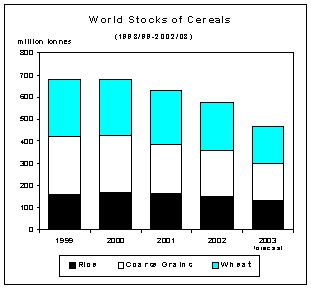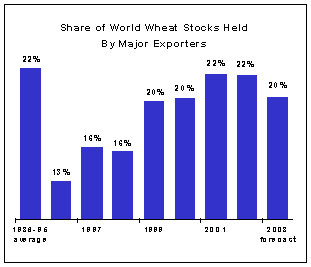Based on the latest FAO cereal production and consumption forecasts for 2002/03, world cereal stocks for crop years ending 2003 are now expected to plunge by 108 million tonnes, or 19 percent, from their opening levels, to around 466 million tonnes, down also 31 million tonnes from the previous report in July. This month’s revision mainly reflects a major downward adjustment to maize and wheat stocks in the United States as a result of reduced crop estimates. Cereal inventories in the United States are currently forecast to decline by as much as 33 million tonnes. Nevertheless, the continuing reduction in stocks held in China, by nearly 44 million tonnes, would still account for a large portion of the anticipated fall in global carryover stocks.

World wheat inventories, by the close of the seasons ending in 2003, are forecast to fall to 168 million tonnes, down 6 million tonnes from the July forecast and 47 million tonnes, or 22 percent, below their opening levels. As in the previous season, most of the reduction is expected in China (down 24 million tonnes), where production has declined again for the third consecutive year, and in three major wheat exporting countries, the United States, Canada and Australia, as a result of sharply reduced outputs. In the United States alone, the expected decline in stocks to 12 million tonnes would place this country’s carryovers at the lowest level since 1996, when they fell to 10 million tonnes. Stock declines in major exporting countries would imply a significant drop in the ratio of their aggregate wheat stocks to their total disappearance (the sum of their domestic consumption and exports), which is forecast to drop to 15.5 percent, down sharply from nearly 21 percent in the previous season and the lowest since 1996 when it was at 14 percent. Similarly, the global share of total wheat stocks held by major exporters could slide to under 20 percent compared to nearly 22 percent in the previous year. While this year’s expected sharp decline of stocks in traditional exporting countries has been supportive to prices, large wheat supplies among non-traditional exporters (though mostly of soft quality), coupled with good production results in a number of key wheat importing countries, could ease this year’s overall supply tightness.

Elsewhere, a stock decline of some 4 million tonnes is expected in India. This would be a welcome development in India where, in order to reduce the financial burden of a large stockpile, the Government continues to promote exports. In Pakistan, while this year’s production is again estimated to be above average, stocks could contract sharply (by nearly 3 million tonnes) because of strong domestic consumption and exports. Relatively elevated exports, despite production declines, could drive down inventories in several other countries as well, including Hungary, Romania and Mexico. Among the CIS countries, higher expected inventories in Azerbaijan, Belarus, Turkmenistan, Ukraine and Uzbekistan are expected to more than offset lower carryover stocks in the Russian Federation (due to large exports) and in Kazakhstan (due to large exports and lower domestic production). Smaller inventories are also in the forecast for a number of countries in Africa, especially in Ethiopia and Tunisia because of production declines this season.
The forecast for world coarse grain inventories for crop years ending in 2003 has been lowered by 21 million tonnes since the previous report to 167 million tonnes, down 41 million tonnes, or almost 20 percent, from the previous year. The most significant downward revision
| Crop year ending in: | |||
| 2001 | 2002 estimate |
2003 forecast |
|
| (. . . . million tonnes . . . .) | |||
| Wheat | 240.3 | 215.4 | 167.9 |
| Coarse grains | 224.0 | 208.5 | 167.5 |
| of which: | |||
| Maize | 179.7 | 158.5 | 125.3 |
| Barley | 25.3 | 27.1 | 21.6 |
| Sorghum | 5.3 | 6.9 | 5.9 |
| Others | 13.8 | 16.0 | 14.7 |
| Rice (milled) | 163.2 | 149.8 | 130.9 |
| TOTAL | 627.5 | 573.6 | 466.3 |
Source: FAO
relates to the United States, where the latest official report (USDA, September 12) puts this year’s coarse grain output at 20 million tonnes below the previous year’s level. As a result, carryovers in the United States could fall to 22 million tonnes, down 24 million tonnes from the previous season; the steepest drop is related to maize, since a sharp decline in its production coupled with strong domestic demand and exports could bring its ending stocks down to a seven-year low of some 18 million tonnes. Overall, total coarse grain stocks held by major exporters could dip to as low as 47 million tonnes, compare to 73 million tonnes in the previous season. Besides the United States, large drawdowns are also expected in Canada and Australia. In the EU, total stocks could decrease, but the overall level would still remain relatively large. Altogether, total coarse grain stocks held by major exporters this season would represent around 28 percent of the world total, which is significantly below an average of 34 percent registered in recent years. In addition, the ratio of major exporters' stocks to their total disappearance is also likely to shrink, falling to only 11 percent, down from 17 percent in the past two seasons and the smallest ratio since 1996.

Elsewhere, in China, despite an expected increase in production, coarse grain inventories (mostly maize) could shrink by at least 8 million tonnes, based on the current forecasts for increased exports and domestic utilization. In addition, sizeable drawdowns are also anticipated in a number of other countries, most significantly in the Russian Federation (down 1 million tonnes, mostly barley), Brazil (down 1 million tonnes, all maize), Turkey (down 1 million tonnes, mostly maize and barley), and Mexico (down 500 000 tonnes, mostly maize). Total stocks in Africa are expected to decline by 1.6 million tonnes driven by production shortfalls (mostly maize) in several countries, especially in southern Africa.

World rice stocks at the close of the crop seasons ending in 2003 are forecast to fall to a 15-year low of 131 million tonnes, since global rice consumption is expected to outpace production for the third consecutive year. This would represent a decline of about 19 million tonnes from their revised opening level and one of the largest within season contractions on record.
Again, much of the global drawdown is forecast to be concentrated in China (down 12.1 million tonnes), where it will be required to bridge the foreseen gap between production and consumption, and in India (5.3 million tonnes), in the face of the anticipated crop shortfall in 2002 and expected strong international sales in 2003. By contrast, rice carryovers are foreseen to remain very large in the other major exporting countries, including Viet Nam, Thailand, Myanmar and the United States. Several major importers, including Indonesia, Brazil and the Philippines, are also likely to reduce their stocks somewhat to cover their domestic requirements.